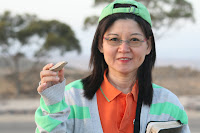The above 2 pictures were taken at the Dead Sea. We floated and read Jewish newspapers on it. Am only showing you a picture of how we look, all covered up with mud which was suppose to have lots of natural minerals to make our skin silky smooth. We even posted in groups and as couples but those pictures are for our eyes only :)

Irene enjoying a SpongeBob ice cream after our Dead Sea Experience at the En Gedi Spa.
Day 6 - We woke up before 5am to attend our 5.30am Sunrise Service at Tel Arad, once the entry to the Negev. Arad is mentioned in the Bible as one of the cities located in the eastern Negev whose inhabitants prevented the Israelites from entering the "Promised Land" (Num 21). Negev in Hebrew means south. Israel's Negev Dessert, where Abraham, Isaac and Jacob tended their flocks, comprises 66%, over 6,700 square miles of Israel. The Negev has an arid and semi-arid climate, defined according to average rainfall (2-6 inches) type of soil and natural vegetation.



Having such poor conditions, the Negev was largely undeveloped and sparsely populated during Israel's first five decades. In spite of this, Israel has succeeded in becoming a world leader in combating the desert and preventing desertification of fertile lands. Through responsible water and soil conservation programs, Israeli techniques have become models in sustainable land management with worldwide implications.



Lesson learnt - May the parched land of our lives blossom like the crocus (Isa 35) because we serve a GREAT GOD!


The beauties and handsome guys from WEFC. Pictures taken with the Negev desert in the background.


Pictures taken outside and in the hotel at Arad. Irene pressing fresh orange juice from a simple juice extractor.


After breakfast, we proceeded to Tel Sheer Sheva. The mound represents an urban ruling centre from the biblical period in the southern part of the country, where excavations revealed a system of walls and gates along with public and residential buildings, a storehouse, water systems and more. Tel Beer Sheva was declared a national park in 1986 and later as a World Heritage site in 2005. It is located in the centre of a wide valley on the northern bank of the Beer Sheva streambed near its confluence with the Hebron streambed.


Together with Arad Valley, the Beer Sheeva Valley, identified with the biblical region of "Negev of Judah" is a wide plain covered with loose soil. These 2 valleys divide the Judean Mountains in the north from the Negev Highlands and the Sinai in the south.


The Observation Tower. From the top you can get a good idea of the plan of the city. At the foot you can see the remains of the fortress built during the Roman period and restored in the early Arab period.


Picture 1 - A freight train passing Beer Sheva. Picture 2 - We took a rest behind one of the walls. Temperature should be around 38 degrees C.



Israelite dwellers built an illegal copy of the tabernacle. Picture 3 shows a replica of the large, sacrificial four-horned altar. The altar shows that the city had a cultic structure, built in the framework of the religious administration of the Judean monarchy. Its dismantling and burial attest to a change in the kingdom's ritual customs. (2 Kings 18).


Picture 1 - Irene in front of a burning bush. It is also called a broom tree. Picture 2 -
red bugs that breakup when disturbed, quite like the scarab of Egypt.


Picture 1 - view of Bethlehem. Picture 2 - herd of sheep as in Bible times.



Shepherd's Field Church, Bethlehem. We sang carols here :)
Frescoes depicting the birth of Christ in Shepherd's Field Church.

STARS & BUCKS Cafe


The Church of the Nativity. It marks the traditional place of Christ's birth. It is also one of the oldest surviving Christian churches. Peter and Hefferich wore shorts, so they were not allowed into the Church. But one of the guards had a skirt, which Hefferich borrowed :)


We attended Baraka Church evening service and gave a special song item.


On our way out of Bethlehem we had to pass through a heavily guarded entrance. Along the walls surrounding Bethlehem you see graffiti depicting desperation and anger.













































No comments:
Post a Comment